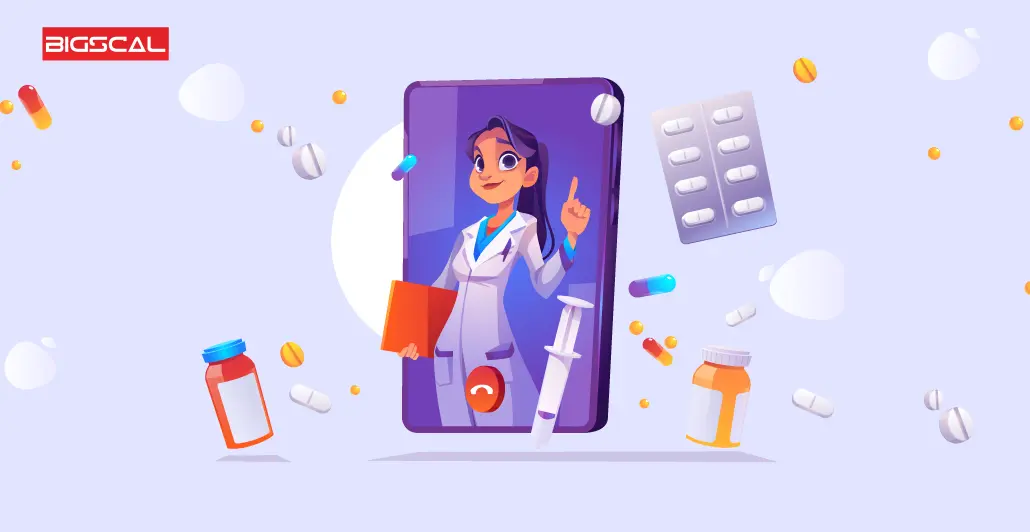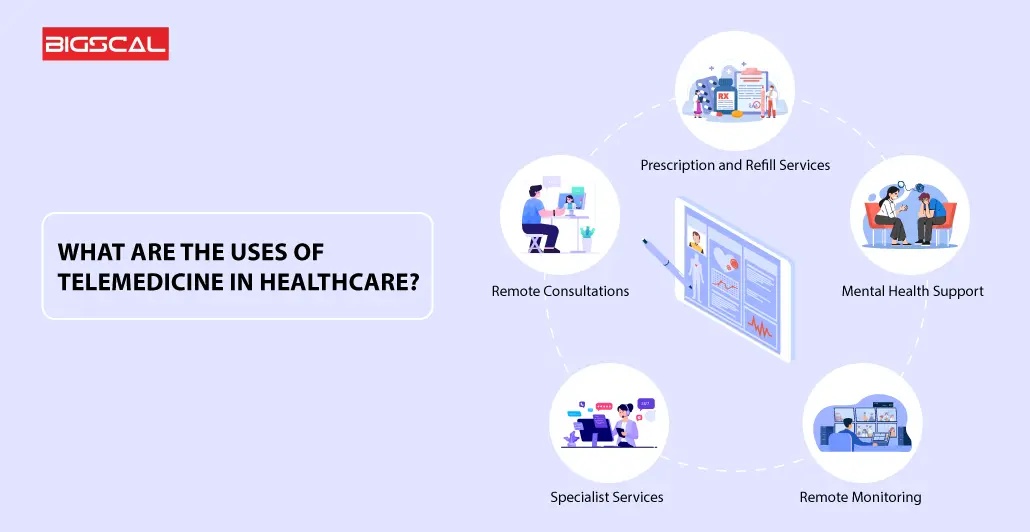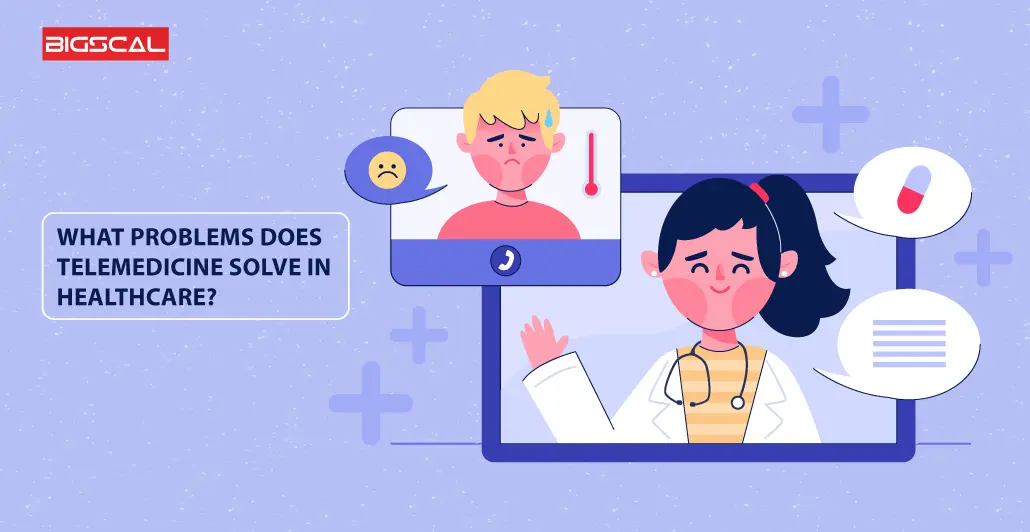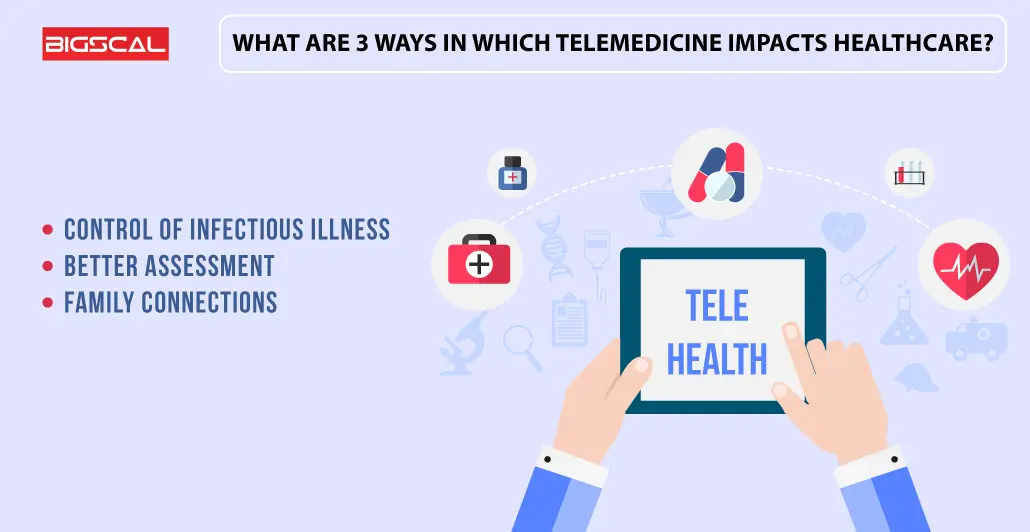The Transformative Impact of Telemedicine in Healthcare
Quick Summary: The impact of telemedicine in healthcare has reshaped by telemedicine, amplifying accessibility, distant consultations, and patient tracking. This technology facilitates convenient virtual sessions, broadens medical reach, advocates proactive healthcare, and enhances patient well-being via consistent monitoring, signifying a radical evolution in healthcare provision.
Introduction
Telemedicine has emerged as one of the most compelling forces that drives transformation in healthcare. It has even brought a noticeable change in how medical services are accessed and delivered. Hence this technology is paving the way for an era that is followed by unprecedented convenience, efficiency, and accessibility in healthcare delivery.
Telemedicine has demonstrated its utility in a variety of ways by removing all geographical barriers and bridging the gap between patients and healthcare professionals.
First, telemedicine has democratized health care by providing remote access to expert medical advice for underserved patients in rural areas. Furthermore, the impact of telemedicine on health has also reduced the burden on traditional health care systems.
It’s more about creating simpler processes with shorter wait times, and a better patient experience. Finally, telemedicine has helped improve disease management and follow-up of chronic diseases.
People suffering from chronic conditions can access continuous monitoring and guidance.
This guide will help understand the impact of telemedicine in healthcare. It will shed light on its role in democratizing health resources and healthcare access, optimizing health care, and revolutionizing long-term patient care.
What is telemedicine?

Telemedicine is a healthcare practice that has been in the limelight recently. It includes remote diagnosis and treatment of patients with telecommunications technology. Hence during virtual visits, a patient can connect with any specialist using video calls, phone conversations, or secure messaging. You have no need to make an appointment for an in-person visit.
Access to telemedicine, probably one of the most appealing advantages of telemedicine, is not tied to geographic restrictions. Thus it ensures even medical access among dislocated or rural areas too.
Another advantage of this service is the liberation as the patient does not have to drive to a pharmacy or hospital but instead receives their prescriptions and advice from somewhere in their comfort zone. This is yet another argument why options like e-learning provide the students with the feeling of their time being valuable, without the additional traveling costs.
E-medicine is essential in providing good services (best prevention) and efficiency by diminishing a mass attendance. Telemedicine, which played a prominent role in healthcare, proved to be useful when a medical crisis occur. The healthcare physicians can take care of patients or reduce the risk of transmitting the disease by controlling the master.
Every day the technology is becoming more and more advanced, and telemedicine is about to revolutionize the nature of health care provision. Which eventually leads to a better availability of quality medical care and the services to people from different parts of the world so makes it more accessible and convenient.
What are the types of telemedicine software?
Real-time video communication
One of the most used and recognized types of telemedicine software is real-time video communication. It helps patients to get in touch with the primary health care providers through video calls, just like in-person consultations. Hence this impact of telemedicine in healthcare facilitates face-to-face interactions for patients to discuss their symptoms. Moreover, it will ensure that patients quickly receive diagnoses and prescriptions.
Healthcare providers can visually assess patients just like a physical exam. They can observe physical symptoms and provide immediate guidance. This direct interaction with physical therapy is especially crucial in urgent care scenarios and better patient outcomes.
Remote based monitoring
Remote-based monitoring telemedicine software will help you continuously track a patient’s condition, vital data, and health status metrics. Hence it is beneficial for patients suffering from chronic conditions requiring care. These patients must use wearables with sensors to measure blood pressure and glucose levels.
Later that data is transmitted to primary care physicians, that detect anomalies using metrics. It will enhance patient outcomes and provide proactive care that reduces the need for frequent hospital visits.
Store-and-forward
Store and forward telehealth software involves securely sharing patient information from electronic health record. This information might include details of medical information from electronic health records like images, test results, and clinical notes among healthcare providers.
Hence this approach lets specialists review cases online patient portal at their convenience across different time zones. This type of software is majorly helpful whenever immediate interaction with a primary care physician or physicians is unnecessary. It expedites the diagnostic process and facilitates collaboration among medical professionals.
What are the uses of telemedicine in healthcare?

Telemedicine has been emerging as a transformative force in modern care. Alongside this, it is also revolutionizing the access and delivery mechanism of medical services. Hence uses of telemedicine platforms create a way for efficient, accessible, and patient-oriented healthcare services. Here are some ways in which telehealth or virtual visit is used in health care:
- Remote Consultations: One of the most basic uses of telemedicine is remote consultations between healthcare providers and patients. With real-time video calls, patients can inform about their issues and gain consultation from primary care providers. Hence without the need for physical travel, a person can gain treatment. It is a beneficial technology for remote areas with mobility challenges.
- Specialist Services: Telehealth services tend to bridge the distance between health care gi and patients. Now patients can consult a specialist without worrying about the location. It’s straightforward these days to have a second opinion for complex cases. Hence it widens the scope of medical expertise. It ensures that patients get the best Medicare services possible.
- Remote Monitoring: Telemedicine facilitates remote patient monitoring through wearable devices and remote sensors. This health record is then sent to the healthcare provider. Remote patient monitoring is valuable for managing chronic conditions, post-operative care, and delivering healthcare services to older adults.
- Mental Health Support: Telemedicine is pivotal in providing psychological health services. Patients can access therapy, counseling, and psychiatric consultations through video chat. People tend not to visit medical centers for such concerns. Hence this makes mental health support more accessible and discreet.
- Prescription and Refill Services: Telehealth adoption allows doctors to prescribe medications and prescription refills electronically. Therefore it can streamline the process for patients. It is incredibly convenient for those with cardiovascular disease, blood pressure, or minor illnesses.
What problems does Telemedicine solve in healthcare?

Here’s how telemedicine effectively addresses some of these problems:
Telehealth addresses health care providers shortages.
Telehealth virtual visit also significantly reduces the impact of a shortage of primary care physicians through telemedicine visits. Hence it enhances healthcare delivery to remote areas with a broader patient base. Patients in underserved regions gain access to health care professionals remotely, which might not be available locally. Through telehealth visits, medical specialists can effectively diagnose, treat and monitor patients for health risks and treatment. Hence it can reduce strain and optimize resource allocation.
Reduces emergency Department Visits
One of the main impacts of telemedicine in healthcare is that it can reduce the strain on the emergency department by developing an alternate route. Certain cases, such as infectious diseases or minor injuries, that typically might land in the room can be managed by telemedicine guidelines. Hence this will save time for multiple providers and enhance satisfaction. Moreover, it could also reduce the burden on the various emergency departments’ wards with virtual consultations.
Personal health records
Telehealth and telemedicine promotes seamless exchange of medical records between healthcare providers and patients. Hence patients need internet access and mobile devices to share their medical history securely. This streamlined information flow enhances diagnostic accuracy, reduces duplicate tests, and minimizes the risk of adverse effects.
Home Hospital Services
Telehealth services empower the concept of home hospitals. Here patients can receive medical care in their homes without transportation. Advanced telehealth services and technologies enable healthcare professionals to record vital signs, administer treatments, and provide guidance. It accelerates patients’ experience and frees up hospital beds for more acute cases. Hence ultimately reducing costs and lessening wait times.
What are 3 impact of telemedicine in healthcare?

Control of Infectious Illness
Telehealth services are a strong guardian that helps win against infection. It allows healthcare providers to ensure Medicaid services to patients with contagious illnesses without physical contact. They can check health remotely using virtual visits to break down infectious disease and transmission. Hence remote patient monitoring can be a pivotal tool during outbreaks like the covid 19 pandemic. It will let a physician swiftly diagnose and manage patients while ensuring safety.
Better Assessment
Telemedicine services provide a platform for more comprehensive and accurate medical assessments. With virtual visits, experts can visually assess patients, enabling them to identify visible symptoms. These symptoms cannot be easily conveyed through traditional telephone consultations in personal visits to a physician’s office. This enhanced assessment leads to more precise diagnoses and tailored treatment plans. It will ensure patients receive appropriate care based on a comprehensive evaluation.
Family Connections
The impact of telemedicine in healthcare also extends beyond the individual patient to their families. It tends to bridge geographical distances, allowing family members to participate actively in consultations and discussions about treatment plans. Hence this virtual involvement fosters a stronger sense of support where family members of patients have all the medical information. Moreover, it will ensure that patients are emotionally connected and receive high-quality care. It permits family members to actively engage in caregiving, promoting a holistic approach to patient well-being.
Why is Bigscal a good choice for Telemedicine app development?
Bigscal is one of the most widely recognized and Top Telemedicine app development solutions providers. We have specialization and an innovative style of telehealth care. Whilst Bigscal gets the experience of building and delivering telehealth visit solutions, their developers are very skilled and can make telehealth service platforms.
Telemedicine apps operated by our highly experienced developers are exceptionally clean and easy to manage. We make security our priority and create a platform, which will make patient information secure, managed by patient portals with protected data in compliance with industry standards.
Also, Bigscal will have the ability to connect various projects to provide more personalized services to match the needs of various patients. IT, jointly with our commitment to thoroughly follow the new technologies, puts us on the top of the list. We are determined to dispense with our state-of-the-art telemedicine app development that will in turn enable healthcare services to rise up to a higher level.
Conclusion
In this fast-paced era of health care, telemedicine has created a big impact on the system and, of course, this has benefited from the system. It has, therefore, left behind an imprint nobody could miss on the entire industry. The ability to monitor patients remotely is in response to one of the most impactful effects in health care. It is a great way of limiting the contagious diseases like Corona Covid-19 as its pandemic illustrates. Thanks to telehealthcare we offer virtual visits allowing our patients to be better diagnosed and their treatment plans to be more individualized. Additionally, the family health centers are designed to facilitate empowerment to both patients and families as this accelerates the holistic approach.
It affects the way health care services are realized and completely changes the standard of health care delivery. The virtual-delivery tool liberates the geographical constraints that significantly change the process of recovery. Nevertheless, given that the telemedicine mechanism is not fully developed yet, it is just good news that it will bring prompt high-quality health care services within the reach of every citizen. Telehealth platform envisages a future in the healthcare building blocks where health services have no blanks.
FAQ
How has telemedicine impacted healthcare?
Harnessing the power telemedicine in healthcare has revolutionized it by providing the convenience of telecommuting and better access to medical experts in general. Additionally, it improves the patient experience, compared to visiting a physician office or medical center. Overall, patients choose the telehealth methods of getting a doctor competent and attendance-packed.
How did telemedicine impact healthcare during the pandemic?
Telemedicine discovered its endless promise when the pandemic came, and now it facilitates safe medical consultations for the public. Overcrowding of the hospitals was also curbed as a result, thus improving the continuous supply of care to other non-COVID patients, achieving another goal of reducing the load on healthcare facilities.
What is telehealth, and how does it affect or change healthcare or the medical field?
Telehealth is e-health provision that involves medical services dispensed over the internet or any other technology. Patient portals online responsive, lower healthcare costs include discounted medicine prices, distance healthcare platforms, and improved patient relations and satisfaction concerning in-person treatment visits. It is creating a paradigm shift in the approach of clinicians and physicians with the emphasis being put on proactive and preventive practices.
What is the trend in telehealth in healthcare?
Telemedicine in healthcare has been hit by the momentum for a long time. The main factors behind the expansion are technological improvements, the rise of patient desires for care delivery at home and telehealth. Consequently, it has the potential to realize a tomorrow in which such virtual visits, consultations, and PSM are readily available.
What are some benefits of telehealth to the patient and the healthcare provider or system?
Telehealth services enhance the welfare of patients through provision of of the medical knowledge to them and saving them money and time spent on the travel and waiting. Furthermore, it helps lessen the pressure on the health system by way of standardization of the allocation of resources, expanding preventive care, and reducing total healthcare expenditure in most cases.





